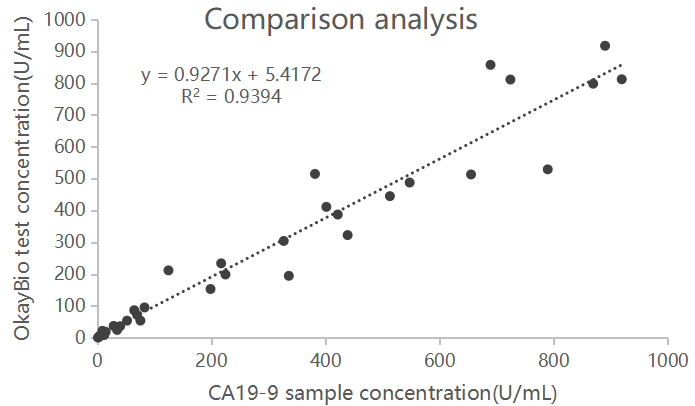Carbohydrate antigen 19-9 (CA19-9)

CA19-9 Antibody
| Name |
Anti-Human Carbohydrate antigen 19-9 (CA19-9) antibody |
| Catalog # |
R272n2 |
R205t6 |
R188c1 |
Platforms
Usage |
Chemiluminescence immunoassay (CLIA) |
R272n2 (Capture)-R205t6 (Detection)
R188c1 (Capture)-R205t6 (Detection) |
| Description |
Mouse monoclonal antibody, cultured in vitro |
| Buffer |
1xPBS,pH 7.4 |
| Purity |
Purity>95%, purified by Protein A/G chromatography |
| Storage |
Aliquot and store at -20°C or lower. Avoid freeze / thaw cycles. |

CA19-9 Antibody Conjugates
CA19-9 Antibody Conjugated Magnetic Beads
| Name |
Catalog# |
| CA 19-9 antibody conjugated magnetic beads |
B310e1 |
| B311e1 |
| B312e1 |
Labeled CA19-9 Antibody
| Name |
Catalog # |
| Biotin labeled CA19-9 antibody |
L323f1 |
| Acridinium ester (AE) labeled CA19-9 antibody |
L320f1 |
| Alkaline phosphatase (ALP) labeled CA19-9 antibody |
L322f1 |

Product Information
Alkaline phosphatase-labeled Chemiluminescence (ALP-CLIA) platform
Correlation in clinical samples
R272n2-R205t6 matched antibody pair was verified in RocheTM serum assigned samples (39 cases, concentration:1.18-919.2U/mL, clinical coefficient of determination R2 > 0.93).
| Sample No. |
Concentration
(U/mL) |
Concentration of Detection
(U/mL) |
| 1 |
1.18 |
0.252 |
| 2 |
2.48 |
2.02 |
| 3 |
3.58 |
4.24 |
| ... |
... |
... |
| 38 |
890.0 |
917.5 |
| 39 |
919.2 |
812.3 |
Fig.1 Correlation of CA19-9 on CLIA platform in clinical samples
Table.1 Correlation data in clinical samples

Introduction to Carbohydrate antigen 19-9 (CA19-9)
Biological functions of carbohydrate antigen 19-9 (CA19-9)
Carbohydrate antigen 19-9 (CA19-9) is a mucin-type carbohydrate protein indicator for tumor, which is a glycolipid on the cell membrane and is generally formed from Lewis antigens (including Le-a and Le-b ) precursors under the joint action of sialyltransferase and fucosyltransferase. CA19-9 is distributed in epithelial cells of pancreas and bile duct of normal human. CA19-9 also exists in the form of salivary mucin in serum, but the content is very low. Studies have shown that CA19-9 can trigger the development of pancreatitis by accelerating the excessive activation of pancreatic epidermal growth factor receptor (EGFR) signaling, leading to the progression of pancreatitis to pancreatic cancer.
Significance of clinical diagnosis
CA19-9 is often applied in the clinical diagnosis of pancreatic cancer and is also used in the clinical auxiliary detection of gastric cancer, colorectal cancer, gallbladder cancer, bile duct cancer and liver cancer. After tumor resection, the concentration of CA19-9 will decrease. If it rises, it may indicate tumor recurrence. However, it should be noted that CA19-9 will also increase under the influence of many benign diseases, and it is difficult to apply it to the screening and early diagnosis of malignant tumors. Therefore, it needs to be detected combined with other indicators, such as: combined detection of CA19-9, CA125, AFP, CEA and HE4 in the diagnosis of ovarian cancer; combined detection of CA19-9, SCCA, CYFRA21-1, and NSE levels in the diagnosis and treatment of non-small cell lung cancer; combined detection of CA19-9, β2-MG and PSA in the diagnosis of prostate cancer; combined ultrasound detection of serum CA19-9 and CA15-3 in the diagnosis of breast cancer.
Reference Range
Table 1. Reference range of CA19-9 in different detection systems
| Detection System |
RocheTM |
Beckman CoulterTM |
SiemensTM |
AbbottTM |
| Reference Range (U/mL) |
≤30 |
≤25 |
≤34 |
≤43 |
Note: Since there is no recognized traceability system for CA19-9, there are differences in test results between various systems.

Related Products

